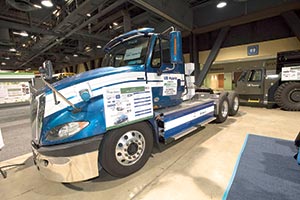Senior Reporter
Zero-Emission Vehicles at Center of Plan to Slash California’s Nitrogen Oxide Levels

This story appears in the May 16 print edition of Transport Topics.
LONG BEACH, Calif. — Zero and near-zero emissions trucks and other freight vehicles are at the center of California’s plan to slash emissions of nitrogen oxides, regulators said. The plan begins with a series of state pilot projects over the next three years, they added.
California’s Sustainable Freight Transportation Action Plan was released just before the Advanced Clean Transportation Expo here earlier this month. The plan outlines steps to reach the emissions goals and lists target areas, including ports, along the U.S.-Mexico border and in agricultural sections of the state. There also are expectations that the state will soon issue a low NOx standard.
“[Using] zero-based emissions technologies everywhere feasible and near-zero everywhere else fueled on renewable energy, that’s the end game,” Heather Arias, chief of the freight transport branch at the California Air Resources Board, said during a session at the expo.
The state is putting more and more funding into this, she said, adding that 2050 is the timeframe for getting the complete system there. But along the way, “significant progress” must be made to meet standards and regulations “coming in play in just a few short years and another [air-quality] standard ratcheting down in 2030.”
An initial step in the action plan is the deployment of more than 100,000 freight vehicles and re-?lated pieces of equipment — a mix of trucks, railroads, ocean-going vessels, cargo-handling equipment and cargo planes — capable of zero-emission operation by 2030, while also maximizing near-zero technologies throughout the system, according to CARB.
The action plan “is a high-level effort to pull together the state’s multiple different environmental, energy, infrastructure and economic development priorities into a single document,” Chris Shimoda, director of policy for California Trucking Association, told Transport Topics.
Shimoda said within the next 20 years the majority of trucks operating within the state will meet a near-zero emission standard, “including interstate [trucks], defined as a truck with 90% less NOx than the level set in the 2010 Environmental Protection Agency emission standard.”
That baseline NOx standard is 0.2 grams per brake horsepower-hour, EPA said.
CARB and the South Coast Air Quality Management District will petition EPA later this year or in early 2017 for a lower NOx standard, said Glen Kedzie, energy and environmental affairs counsel for American Trucking Associations. “The gist of it is, it’s going to happen. There are discussions ongoing with all the players involved: [engine] manufacturers, CARB and EPA,” said Kedzie, formerly an attorney with EPA.
But Kedzie said California’s low NOx standard “could hit smack dab in the middle” of the implementation of Phase 2 of EPA’S greenhouse-gas rule, which is expected later this year. Phase 2 will require additional pollution-control technology on diesel engines, tractors and 53-foot trailers.
He said typically there is an adverse impact on fuel consumption as a result of lowering NOx further. Engine manufacturers have spent the past few years adjusting engines coming on the market in 2017 to increase fuel efficiency, per the EPA’s GHG rule.
“We saw that in 2004 and again in 2007. That justifies one of our comments to the Phase 2 rule — the need for a mid-course review,” Kedzie said.
Shimoda said chances are slimmer for zero-emission technologies like battery electric motors and hydrogen fuel cells being used by 2030 “with even a majority” of truck-based shipments given those vehicles’ range-related limitations and likely high cost, plus the lack of supporting infrastructure.
Shimoda estimated there are 350,000 Class 8 trucks operating in the state and another 650,000 Classes 3-7 trucks, for 1 million commercial vehicles, overall.
He said the majority of trucks will continue to use diesel until an alternative fuel can compete from a “cost, performance and environmental standpoint. Natural gas is the closest competitor, with major OEM and vendor support, but to put this in context, only 1.8% of the [California] fleet is running on either compressed or liquefied natural gas.”
However, Mike Spence, senior vice president at fleet analytics firm Fleet Advantage, predicted there will be an increase in the use of all electric and hybrid-electric heavy-duty vehicles “as we move through the next 10 to 20 years and will represent a technology that can be more widely used than imagined today.”
Arias summed up the situation for TT after the session ended.
“So a lot of the things we are trying,” she said, “are to help to make the changes at the federal level so that there is change that is consistent across the whole United States.”

